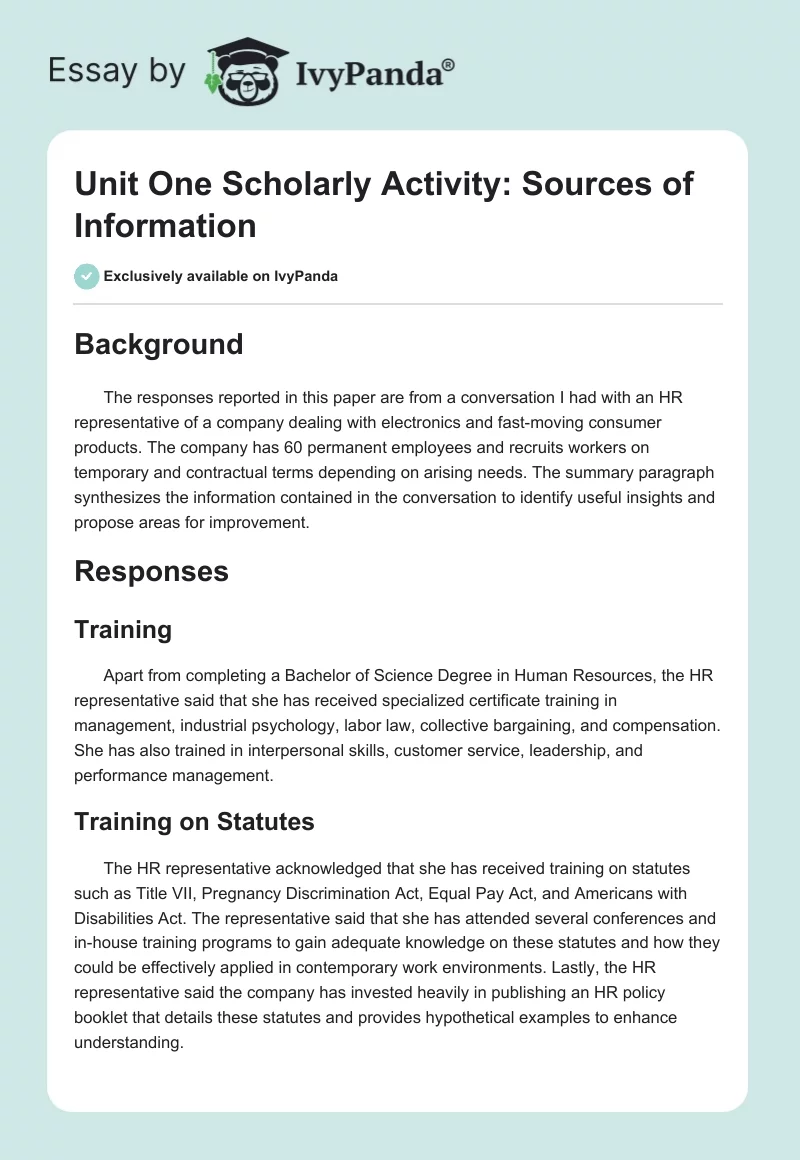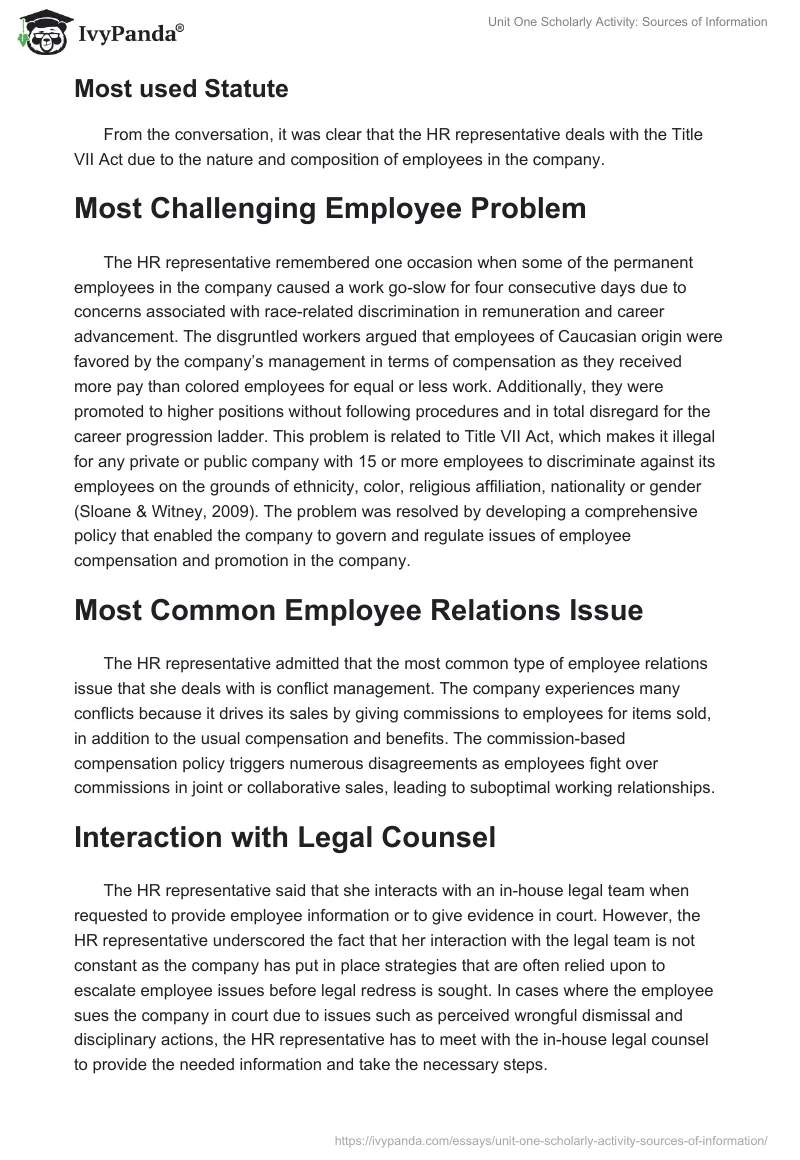Background
The responses reported in this paper are from a conversation I had with an HR representative of a company dealing with electronics and fast-moving consumer products. The company has 60 permanent employees and recruits workers on temporary and contractual terms depending on arising needs. The summary paragraph synthesizes the information contained in the conversation to identify useful insights and propose areas for improvement.
Responses
Training
Apart from completing a Bachelor of Science Degree in Human Resources, the HR representative said that she has received specialized certificate training in management, industrial psychology, labor law, collective bargaining, and compensation. She has also trained in interpersonal skills, customer service, leadership, and performance management.
Training on Statutes
The HR representative acknowledged that she has received training on statutes such as Title VII, Pregnancy Discrimination Act, Equal Pay Act, and Americans with Disabilities Act. The representative said that she has attended several conferences and in-house training programs to gain adequate knowledge on these statutes and how they could be effectively applied in contemporary work environments. Lastly, the HR representative said the company has invested heavily in publishing an HR policy booklet that details these statutes and provides hypothetical examples to enhance understanding.
Most used Statute
From the conversation, it was clear that the HR representative deals with the Title VII Act due to the nature and composition of employees in the company.
Most Challenging Employee Problem
The HR representative remembered one occasion when some of the permanent employees in the company caused a work go-slow for four consecutive days due to concerns associated with race-related discrimination in remuneration and career advancement. The disgruntled workers argued that employees of Caucasian origin were favored by the company’s management in terms of compensation as they received more pay than colored employees for equal or less work. Additionally, they were promoted to higher positions without following procedures and in total disregard for the career progression ladder. This problem is related to Title VII Act, which makes it illegal for any private or public company with 15 or more employees to discriminate against its employees on the grounds of ethnicity, color, religious affiliation, nationality or gender (Sloane & Witney, 2009). The problem was resolved by developing a comprehensive policy that enabled the company to govern and regulate issues of employee compensation and promotion in the company.
Most Common Employee Relations Issue
The HR representative admitted that the most common type of employee relations issue that she deals with is conflict management. The company experiences many conflicts because it drives its sales by giving commissions to employees for items sold, in addition to the usual compensation and benefits. The commission-based compensation policy triggers numerous disagreements as employees fight over commissions in joint or collaborative sales, leading to suboptimal working relationships.
Interaction with Legal Counsel
The HR representative said that she interacts with an in-house legal team when requested to provide employee information or to give evidence in court. However, the HR representative underscored the fact that her interaction with the legal team is not constant as the company has put in place strategies that are often relied upon to escalate employee issues before legal redress is sought. In cases where the employee sues the company in court due to issues such as perceived wrongful dismissal and disciplinary actions, the HR representative has to meet with the in-house legal counsel to provide the needed information and take the necessary steps.
Dispute Resolution Mechanisms
Finally, the HR representative acknowledged that the company uses several dispute resolution mechanisms to deal with employee issues and concerns. These mechanisms include maintaining an open-door policy to allow employees to voice their concerns and have the issues addressed internally, mediating between conflicting parties, peer tribunals, arbitration, and negotiating interests. These dispute resolution mechanisms, according to the representative, are used according to the context of employee problems and parties involved.
Summary Paragraph
The conversation is insightful in terms of providing information on training requirements for HR representatives, statutes governing labor relations, contemporary employee relations issues, and dispute resolution mechanisms used by companies to address employee concerns. Indeed, a major learning point that can be synthesized from the conversation is that HR professionals have a significant role to play in addressing most of the issues that affect employees. These issues have the capacity to lead to other adverse outcomes for the organization if they are not addressed properly. However, in my view, the HR representative needs to advance her knowledge on conflict resolution and compensation issues because most of the problems that have been reported originate from these two core areas. For example, the representative can enroll in an alternative dispute resolution (ADR) course to gain important insights on how to deal with employee conflict without negatively affecting the parties involved. Additionally, it is important for the representative to obtain more knowledge on current employment laws and practices to ensure that she is able to deal with contemporary employee concerns as they arise (Walsh, 2013). Lastly, it is important for the HR representative to develop an adequate understanding of how the dynamics of the United States labor laws operate to ensure that the rights of employees are not violated as the company attempts to meet its profit-oriented objectives.
References
Sloane, A.A., & Witney, F. (2009). Labor relations (13th ed.). New York City: Pearson.
Walsh, D.J. (2013). Employment law for human resource practice (4th ed.). Mason, OH: South-Western.


